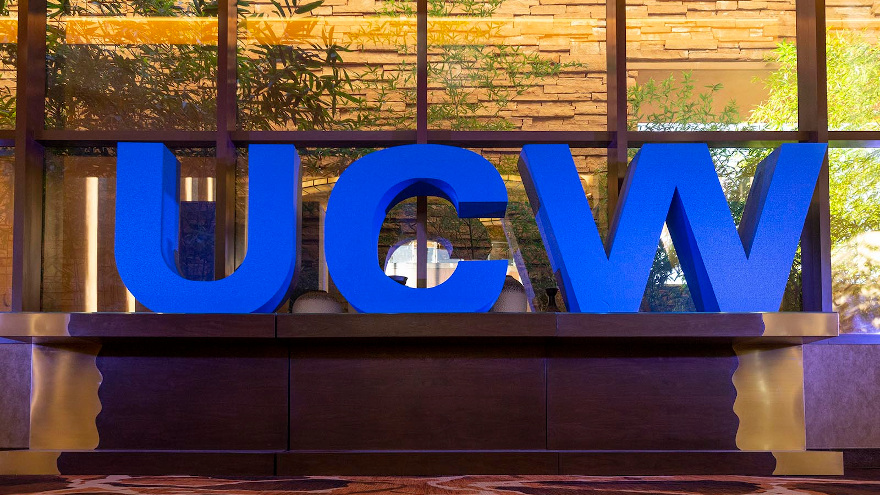As part of its expectations for the 2020 credit market, TransUnion acknowledged that issues surrounding vehicle affordability will continue to persist in the coming year.
But with the Federal Reserve leaving interest rates unchanged this week — and policymakers alluding to the option of repeating the action throughout 2020 — there appears to be some momentum in place to help the auto-finance industry.
Members of the Federal Open Market Committee (FOMC) voted unanimously to maintain the target range for the federal funds rate at 1.50% to 1.75%.
Policymakers explained the labor market remains strong and economic activity has been rising at a moderate rate. They added job gains have been solid, on average, in recent months, and the unemployment rate has remained low.
“As long as incoming information about the economy remains broadly consistent with this outlook, the current stance of monetary policy likely will remain appropriate,” Fed chair Jerome Powell said this week after the latest interest-rate announcement.
“Looking ahead, we will be monitoring the effects of our recent policy actions, along with other information bearing on the outlook, as we assess the appropriate path of the target range for the federal funds rate. Of course, if developments emerge that cause a material reassessment of our outlook, we would respond accordingly. Policy is not on a preset course,” Powell continued.
Considering how interest rates play a role in auto financing, Cox Automotive chief economist Jonathan Smoke made these points on the company’s blog.
“The rate cuts in 2019 did not help the average car buyer. Rates have actually gone up dramatically — more than 2 full percentage points — for consumers with subprime credit,” Smoke said. “Most of the rate gains for borrowers with good credit preceded the last Fed meeting.
“The one factor that could lead to better rates would be more zero or low APR offers from captive finance companies,” he continued. “Those offers tend to be only for consumers with good credit. But with new vehicle supply down, manufacturers may be more conservative over the winter months with incentivized rates.”
No matter the APR, TransUnion expects the amount of risk finance companies absorb will be on the rise.
Analysts projected that average auto balances are expected to grow 1.6% year-over-year by Q4 2020, a slightly slower rate of growth than what they observed in Q4 of this year (1.9%).
TransUnion thinks certain segments of consumers may look to offset these rising costs by opting for extended contract terms, a recent trend taking place in the market.
TransUnion added that originations will flatten relative to 2018, and the share of originations in the prime and above risk tier will remain steady at 66.5%.
“The growth pattern of new auto sales will remain concentrated toward prime and above consumers, while the overall growth curve will flatten in 2020 due to declining new-vehicle sales, said Satyan Merchant, senior vice president and TransUnion’s auto line of business leader.
“External pressures such as higher gas prices and the looming threat of auto tariffs, combined with rising vehicle prices, are all contributing to the concern of auto affordability,” Merchant continued in a news release. “Despite these headwinds, loan performance in the auto industry remains strong.
“We expect the auto delinquency rate to decrease at a higher rate on a year-over-year basis during the first half of 2020, and serious delinquencies are expected to slightly decline by the end of next year,” he went on to say.
Editor’s note: More 2020 expectations will be included in upcoming online and print reports published by Cherokee Media Group.
On Wednesday, four leading executives from EFG Companies made their 2020 predictions and recommendations for the retail automotive and powersports F&I markets.
With what they see as potentially another flat year on the horizon, the EFG leaders predicted that the biggest changes will revolve around process improvements to better compete with industry disruptors and capitalizing on changing consumer purchasing habits.
Over the last few years, EFG acknowledged the auto industry has seen a significant number of disruptors enter the retail automotive space, from ride-hailing services like Uber and Lyft, to companies challenging the way people purchase vehicles, like CarMax and Carvana.
Now, the industry is at the beginning of a re-alignment with these disruptors and evolving consumer purchasing habits, according to the EFG leaders.
“The pace of change affecting the auto retailing industry today is unprecedented. However, it’s important to remember that the goal of the dealership hasn’t changed,” the company said. “The goal is still to sell vehicles profitably. The primary challenge facing dealers today is evolving their retailing process to capitalize on changing consumer habits.”
Utilizing its 40-year history in the F&I industry, EFG Companies offered the following predictions:
Online sales
“Consumers have been driving the need for dealers to invest in online sales models for the last few years. However, the technology just wasn’t there. We’re on the brink of automotive retail technology catching up with consumer demand. I believe over the next few years, we will see dealers more heavily invest in an online sales model. Aside from the logistics of completing a purchase online with the right technology solutions, the role of the BDC will change, hiring and training will change, and data security and fraud prevention will be top of mind.
—John Pappanastos, president and chief executive officer of EFG Companies, who elaborated more about his projections in this online video
Service drive investment
“On the service side, dealers have come to the realization that they need a different type of service advisor. Going forward, salesmanship needs to enter the mix of service manager requirements. The agents we work with are training service managers to answer the question, ‘Why get your work done with my dealership?’ This is a shift in mindset that requires ongoing training, pay plan changes, and creative customer service value-adds, such as door-to-door pickup and delivery, price matching on tires, and complimentary services. It includes streamlining basic services, like oil changes, to keep customers moving. And, it includes tech upgrades in the service center for advisors to provide more transparency and to communicate with customers in the manner in which they want to be communicated. A great example of this is the rise of sending customers video inspections of their vehicles.”
—Adam Ouart, vice president of agency services
Finance and lease creativity
“Over the last several years, dealers and auto lenders have pushed the boundaries of auto lending. We’re now seeing terms as long as 72 months, but auto payments still average more than $400. These boundaries were pushed to lessen monthly payments and make more expensive cars more accessible. However, that clearly isn’t working. If it was, used cars would not have such a strong market position across all credit tiers. Going forward, we can expect dealers to find creative ways to shorten terms and trade cycles. We’ll see more lease options with more granular terms to match consumer buying and driving habits. This need is also driving the rise of subscription-based models in the dealership.”
—Brien Joyce, vice president of specialty services
Five-year outlook
“Dealerships probably won’t look much different than now. The biggest changes dealers will have to make will be cultural and process-oriented. The first priority of all dealerships is to provide an exceptional customer experience. While this isn’t new, the stakes are higher. Going forward, dealers will have to adjust their sales model to enable customers to purchase their vehicle based on their own personal preferences, whether that’s online, over the phone, or in the showroom. To incentivize more foot traffic, dealerships will become more attractive places to visit. You’ll see greater concierge services, like vehicle delivery and pickup, and the dealership will become a place that allows the dealer to build a community.
—John Stephens, executive vice president of EFG Companies
Recent Federal Reserve data shows that more than 4 million Americans are more than 90 days late on their car loan payments.
There are many reasons someone may default on an auto loan: job loss, health emergency or an expensive car repair. And as the U.S. Financial Diaries project demonstrated, Americans face increasing income and expense volatility, which can quickly lead to financial distress. However, this high level of auto-loan defaults, combined with the rapid growth of auto-loan debt (an increase of more than 60% since 2012), suggests something else may be at work.
About 107 million Americans have an auto loan and, according to the Center for Responsible Lending, while 80% of these were indirect bank loans originated at a car dealership. To better understand how these loans are made and the possible reasons why more people are defaulting, our team went undercover in Fresno, Calif., where we went on field visits with debt collectors, listened to collections calls and tried to buy used cars at a number of car lots.
Several dealers began negotiations with prospective borrowers by asking how much they can afford every month. While focusing on this monthly number may seem like a good idea, it often masks the interest rate, term, and total cost of the auto loan. A survey of more than 600 auto loan borrowers suggests that this framing is partly responsible for the industry’s increase in average loan terms — from 62 months in 2010 to 68 months in 2017.
Sometimes consumers get loans they cannot afford. Auto loan delinquencies rose more than any other category in 2016, according to recent data from the American Bankers Association.
It seemed apparent to us that one way to combat this trend was to better arm consumers with more accurate budget and affordability information. To help, we designed and launched a prototype for a new auto loan calculator.
Most auto loan calculators don’t tell the whole story, focusing only on the cost of the car or loan and relying on the borrower to frame affordability or budget. Instead, we built a calculator that focuses on determining how much someone should borrow not just what they can borrow.
By considering the realistic costs of car ownership like insurance, gas, maintenance and repairs, as well as a person’s income, savings goals, and expenses, this type of calculator should help consumers identify the opportunity cost of car ownership. But does it really work?
To test how using the calculator could change consumers’ purchasing decisions, we ran an experiment using more than 1,500 consumers. By asking them to estimate the costs of vehicle ownership, then having them complete the calculator to more accurately assess these costs, we were able to have a significant influence on cost estimates.
The first key takeaway was that the auto calculator helped reduce the estimated sticker price people think they can afford from $15,000 to $12,500. Second, the calculator helped people better remember and assess car-related costs. We asked users to estimate how much they would spend each month on gas, repairs and insurance before using the calculator. That assumption of $50 per month in additional expenses rose to $89 per month after they used the calculator — a 78% increase.
Simply by priming the user to remember costs and accounting for them when considering the total monthly cost of a car, we found it’s possible to enable consumers to generate a more accurate picture of vehicle affordability. Ultimately, we can imagine significant consumer benefits from requiring car dealerships to post monthly costs at the point of car purchase for car payments as well as expected gas, repairs & maintenance, and insurance, and a total monthly car amount.
Of course, it would be naïve to think that a company or person charged with selling something won’t, in fact, try to sell it aggressively. However, given additional tools and better perspective on their overall financial health, we believe consumers can and will make smarter car purchase decisions. While this calculator can certainly help, the opportunity exists for the auto loan industry and its stakeholders to build on this prototype approach to craft even more powerful ways to equip future car buyers.
Wendy De La Rosa is co-founder and Richard Mathera is an advisor to Common Cents Lab, which is a financial and behavioral-science based research program out of Duke University and is in association with the Center for Advanced Hindsight.
iA Financial Corp., one of Canada’s largest insurance and wealth management companies, secured a larger amount of the dealer warranty business in the United States last week.
According to a news release, iA Financial, the holding company of iA Financial Group, announced today that it has entered an agreement to acquire the American company IAS Parent Holdings and its subsidiaries. The agreed purchase price is $720 million.
Based in Austin, Texas, IAS is one of the largest independent providers of solutions in the U.S. vehicle warranty market with more than 600 employees and more than 35 years of history. IAS provides a comprehensive portfolio of vehicle warranties and related software and services sold through one of the industry’s broadest and most diverse distribution networks consisting of over 4,300 dealers in all 50 states.
iA Financial highlighted this acquisition is highly complementary to the company’s existing warranty operations in the U.S. with respect to product suite, distribution networks and geographic scope. At the beginning of 2018, the company finalized its purchase of Dealers Assurance Company and Southwest Reinsure Inc., a company collectively known as DAC.
Denis Ricard, president and chief executive officer of iA Financial Group, explained the synergies from the combined operations will create a true center of excellence in dealer services that will provide a platform for future growth.
“This transaction leverages the expertise and experience in dealer services that iA Financial Group has built over the last 20-plus years in Canada and more recently in the U.S. through the acquisition of Dealers Assurance Company in 2018,” Ricard said in the news release.
“The U.S. market for extended auto warranties, valued at almost $39 billion, is highly-fragmented and provides significant opportunity for organic growth and consolidation,” he continued. “Our investment in IAS will enable us to be a best-in-class provider of vehicle warranty products and services.”
The company said this acquisition will be funded by iA Financial Group’s excess capital. After the transaction closes, the pro forma solvency ratio of the company will 117%.
The company expects the contribution from this acquisition to be neutral to earnings per share in the first year and accretive as of the second year.
iA Financial this transaction is expected to close in the first half of 2020, subject to obtaining the usual regulatory approvals in Canada and the United States, and other customary closing conditions.
“We look forward to this new chapter in our U.S. expansion with great optimism, combining IAS with our already well-established presence in the United States and leveraging our strong track record in dealer services in Canada,” said Mike Stickney, chief growth officer of iA Financial Group and head of the company’s U.S. operations since 2005.
“This acquisition expands our customer offering by bringing an end-to-end product suite and omni-channel distribution, as well as reinforcing our national breadth,” Stickney continued. “Along with the high-quality senior management of IAS who will be joining our organization, we will have the platform to pursue our growth strategy in the vehicle warranty market in the United States.”
Patrick Brown, president and chief executive officer of IAS, touched on what the acquisition means for that operation.
“The IAS team is excited to become part of the iA family. I am very proud of our team’s hard work and record growth the last few years,” Brown said.
“Going forward, as part of a publicly traded company with a market capitalization of more than $7.0 billion, we are well-positioned to continue the long-term support of our valued distribution partners and to deliver on our mission of empowering vehicle owners to avoid unforeseen repair costs,” he went on to say.
At least from an interest-rate perspective, new vehicles looked a bit more attractive to buyers in November, even though retail prices for those models continued to climb.
Meanwhile, financing for used vehicles stayed on a steady course, according to the November information compiled by Edmunds.
Edmunds reported this week that the average interest rate for new-vehicle financing in November dropped to its lowest level of 2019 — and lowest level seen since February 2018. The annual percentage rate (APR) on new financed vehicles averaged 5.5% in November, compared to 5.7% in October and 6% in November of last year.
Edmunds data showed that 21.8% of shoppers who financed their vehicle purchases in November got an interest rate below 3%, compared to 18.6% of those who financed purchases in November.
On the used-vehicle side, the average APR came in at 8.3% in November, nearly flat compared to the previous month and year.
Edmunds executive director of insights Jessica Caldwell explained how the opening to the holiday shopping season impacted the November data.
“Shoppers who made it out to the dealership this November got to take advantage of some of the biggest bargains all year thanks to a combination of Black Friday and model-year sell-down promotions,” Caldwell said in a news release.
“Auto loan interest rates still aren’t as low as they were a few years ago, but it’s encouraging to see that shoppers are landing more attractive financing offers as rates continue to trend downward,” she continued.
While interest rates declined, Edmunds noted that new vehicle prices continued to rise in November. Edmunds data indicated that the average transaction price for a new vehicle climbed to an all-time high of $37,981 in November, compared to $37,188 last year and $33,282 five years ago.
“We typically see a lift in large truck and luxury vehicle purchases at this time of year, but these rising vehicle prices are also a reflection of car shoppers opting for bigger vehicles with more options across the board,” Caldwell said.
The valuation analysts at Kelley Blue Book reported similar rises in new-vehicle prices.
KBB analysts estimated average transaction price for a light vehicle in the United States was $38,393 in November. New-vehicle prices increased $387 or 1% from November of last year, while climbing $106 or 0.3% compared to the previous month.
“Transaction prices rose only 1% as dealer discounts grew to move older inventory,” Kelley Blue Book analyst Tim Fleming said in a news release.
“As retail sales slowed by more than 2% this year, vehicles are spending more time on dealer lots, about 80 days on average, which is five days longer than a year ago and the highest level seen since 2017,” Fleming continued. As a result, there are more discounts and incentives, especially now that the year’s end is approaching.”
Other experts from the Cox Automotive family of companies also shared their assessment of November sales and financing activities. The rundown of recaps began with Charlie Chesbrough, who is senior economist at Cox Automotive.
“The U.S. consumer, motivated in part by low unemployment rates, continues to drive the economy forward,” Chesbrough said. “Vehicle shoppers in November were met with good discounts on older inventory and responded accordingly. November’s results will likely keep the industry on pace to sell 17 million units in 2019, slightly above our full-year forecast of 16.8 million.
“The bottom line here: Strong labor and equity markets continue to provide the foundation for robust vehicle demand. Until either of those changes substantially, strong vehicle markets are likely to continue,” Chesbrough added.
Autotrader executive editor Brian Moody touched on the kinds of vehicles people are buying nowadays, refuting a perception that individuals are only going for SUVs and pickups.
“While the Detroit automakers may believe cars are bad business, the Japanese and Korean automakers view the market differently,” Moody said. “They are investing in good sedans; consumers, turned away by the Detroit Three, are finding what they want from the Asian brands.
“Nissan and Toyota actually delivered increases in year-over-year car sales. Honda and Hyundai saw only small declines in car sales last month. Don’t believe the mainstream media talking point — cars are not dead in America,” Moody went on to say.
And finally, Brad Korner, who is general manager of Cox Automotive Rates and Incentives, returned back to topics also noted by Caldwell over at Edmunds.
“With older inventory plentiful and aggressive incentives in place, there were many good deals in the auto market last month. By our count, incentive program volume in November was at its highest point since July. In all, 2019 is on course to set a record for program volume. In other words, there has never been more incentives in play,” Korner said.
“Interestingly, counter to trend, Nissan and Infiniti have been dialing back this year and showing a downturn in sales,” he continued. “The number of unique programs offered last month was well below November 2018, resulting in less money for discounts to manipulate pricing and payments. Clearly, Nissan is working to rein in the number of deals they have in the market.”
New-Car Finance Data
|
|
November 2019
|
November 2018
|
November 2014
|
|
Term
|
69.3
|
69.1
|
67.0
|
|
Monthly Payment
|
$568
|
$551
|
$492
|
|
Amount Financed
|
$33,472
|
$31,877
|
$28,769
|
|
APR
|
5.5
|
6.0
|
4.5
|
|
Down Payment
|
$4,365
|
$4,164
|
$3,560
|
|
Average Transaction Price
|
$37,981
|
$37,188
|
$33,282
|
Used-Car Finance Data
|
|
November 2019
|
November 2018
|
November 2014
|
|
Term
|
67.5
|
67.3
|
65.5
|
|
Monthly Payment
|
$413
|
$409
|
$369
|
|
Amount Financed
|
$22,512
|
$22,004
|
$20,041
|
|
APR
|
8.3
|
8.7
|
7.6
|
|
Down Payment
|
$2,710
|
$2,643
|
$2,220
|
Source: Edmunds
Amid all of the Black Friday retail activities, RouteOne announced that CRB Auto is now an available eContracting finance source for dealers utilizing the RouteOne platform.
The companies reiterated that eContracting can enable the digital exchange of critical contract documents and data between dealers and finance sources to increase efficiency and reduce contracts in transit.
RouteOne said it now has more than 8,800 active eContracting dealers and more than 80 finance sources in its rapidly growing eContracting customer base. RouteOne is an industry leader in eContracting, with more than 75% of its credit application volume now available to be eContracted.
“We are proud to welcome CRB Auto and bring our dealers yet another available eContracting finance source,” said Jeff Belanger, RouteOne’s senior vice president of business development.
Belanger continued in a news release, “eContracting is rapidly becoming the industry standard and RouteOne is proud to support our owners and customers in leading the charge with our robust offering of features, finance source availability and dealer utilization.”
CRB Auto chief executive officer Bill Katafias added, “CRB Auto’s digital contracting solution will improve convenience, efficiency and speed for our dealer clients through RouteOne.
“In the future of indirect auto, eContracting will let us more easily manage contracts and share key information with our dealer clients,” Katafias went on to say.
Dealers interested in eContracting should contact their RouteOne business development manager at (866) 768-8301 or www.routeone.com/salesteam.
As part of our collection of podcasts originating from Used Car Week 2019, Nick Zulovich shared a conversation with the leadership of the National Automotive Finance Association.
Current president Joel Kennedy and executive director Jack Tracey discussed what they’re hearing from members and what the NAF Association has in store for 2020.
To listen to this episode, click on the link available below.
Download and subscribe to the Auto Remarketing Podcast on iTunes or on Google Play.
After revealing a change in its latest quarterly report about how dealer fees are collected, Credit Acceptance Corp. also recently shared the details about its completion of a $351.7 million asset-backed non-recourse secured financing.
Pursuant to this transaction, Credit Acceptance said it contributed contracts having a value of approximately $439.6 million to a wholly-owned special purpose entity, which will transfer the contracts to a trust. That trust will issue three classes of notes, including:
| Note Class |
Amount |
Average Life |
Price |
Interest Rate |
| A |
$237,500,000 |
2.61 years |
99.98459% |
2.38% |
| B |
$67,900,000 |
3.51 years |
99.98063% |
2.86% |
| C |
$46,300,000 |
3.81 years |
99.97727% |
3.06% |
Credit Acceptance explained the Financing will accomplish three objectives, including:
— Have an expected annualized cost of approximately 2.9% including the initial purchaser’s fees and other costs
— Revolve for 24 months after which it will amortize based upon the cash flows on the contributed contracts
— Be used by the company to repay outstanding indebtedness
Credit Acceptance said it will receive 6.0% of the cash flows related to the underlying consumer contracts to cover servicing expenses. The company added the remaining 94.0%, less amounts due to dealers for payments of dealer holdback, will be used to pay principal and interest on the notes as well as the ongoing costs of the Financing.
“The financing is structured so as not to affect our contractual relationships with our dealers and to preserve the dealers’ rights to future payments of dealer holdback,” company officials said in a news release.
Credit Acceptance pointed out the notes have not been and will not be registered under the Securities Act of 1933 and may not be offered or sold in the United States absent registration or an applicable exemption from registration requirements.
Meanwhile, Credit Acceptance also addressed the topic of its dealer network when it reported its third-quarter financial statement. The company explained that beginning on Aug. 5, dealers were able to enroll in its portfolio program without incurring an enrollment fee.
Prior to August 5, Credit Acceptance noted that dealers enrolled in its portfolio program either by paying an up-front, one-time fee of $9,850, or agreeing to allow the finance company to retain 50% of their accelerated dealer holdback payment(s) on the first 100 consumer retail installment contract assignments.
Credit Acceptance also mentioned that access to its purchase program is typically only granted to dealers that meet one of the following:
— Assigned at least 100 consumer contracts under the portfolio program
— Franchised dealership
— Independent dealership that meets certain criteria upon enrollment
Credit Acceptance reported that it closed the third quarter with 9,555 active dealers, representing a 10% lift year-over-year. The company classifies active dealers as operations that have received funding for at least one contract during the quarter.
As a result of its change, Credit Acceptance responded to questions from investment analysts about how not only the strategy change would impact its financial statement, but also whether the company could continue to generate double-digit growth in its dealer network.
“So we eliminated the fee, obviously, to get rid of an obstacle to growing the dealer program. But it’s hard to say how that will play out in the enrollment metrics going forward,” Credit Acceptance chief executive officer Brett Roberts said during the company’s latest quarterly conference call.
Consumers appear to have a notable desire to purchase a vehicle amid the upcoming holiday shopping season. Their sureness that a finance company will underwrite the contract so they can take delivery doesn’t appear to be on the same level.
The latest Capital One Auto Navigator survey reveals only 26% of respondents feel very confident when shopping for a car. While this is a 6% increase over 2018, Capital One found that respondents attribute three reasons for being wary about their vehicle-purchase prospects, including:
— Low confidence to not having finances in order prior to visiting a dealership: 27%
— Not researching nor knowing what vehicle they want: 43%
— Past experience: 28%
In addition, only 24% of Capital One survey participants said they are “a boss” when it comes to negotiating during vehicle buying, a number that also saw a slight increase (8%) over last year (16%).
“Car shopping should be enjoyable instead of stressful, and with a little pre-work, consumers can ensure their decision complements their lifestyle and budget,” Capital One Auto Finance managing vice president Jeffrey Rabinowitz said in a news release.
“We found that 88% of consumers surveyed understand what it means to pre-qualify for financing, but only half are willing to try it,” Rabinowitz continued.
The survey of 1,004 U.S. adults ages 18 and older was conducted on behalf of Capital One Auto Finance using Engine Insight’s Online CARAVAN® omnibus. Of the 1,004, 693 do not work at a car dealership or ad/public relations company, have purchased a vehicle in the past, are planning to get an auto loan or ever had one. The survey was fielded September 5-8.
Additional findings from the survey include:
— Based on survey responses, finance is not only the consumers’ biggest concern during the car-buying process, but also the most time consuming and stressful.
— 75% of respondents put budget in their top three elements to consider when buying a vehicle.
— There is a division among the most important financial factors when purchasing a vehicle. The survey determined 28% of respondents looking for the lowest monthly payment, 27% focused on final sale price of the vehicle and 20% concerned with total cost of ownership.
— The most time-consuming task at the dealership is working with and signing paperwork with the finance department, according to 52% of respondents.
Based on survey responses, shoppers crave improvements to the vehicle-buying experience.
Capital One discovered 57% of respondents are looking for improvements to the vehicle-buying process, particularly transparency in financing options, negotiations and more clarity on dealer incentives and promotions.
To help, Rabinowitz suggested a tool offered by Capital One.
“With Auto Navigator, consumers can pre-qualify for financing with no impact to their credit score, and with our Auto Learning Center, they can research all aspects of car shopping,” he said. “This transparency allows consumers to feel more confident in their car-buying experience.”
Auto Navigator by Capital One provides a digital inventory of nearly four million vehicles from almost 13,000 participating dealerships across the nation. Auto Navigator further supports consumers by allowing them to see if they pre-qualify for financing with no impact to their credit score, saving them time before heading to the dealership.
Subprime, near-prime and prime year-over-year origination growth all saw year-over-year declines for the first time since a six-quarter pullback that lasted from the third quarter of 2016 to the fourth quarter of 2017, according to a new report from TransUnion.
But even with those declines, according to TransUnion’s Q3 2019 Industry Insights Report released on Wednesday, steadiness was a recurring theme.
“New Vehicle Sales Slow but Performance Remains Steady,” was the heading for the auto section of the TransUnion report.
The report addressed various sectors, but in addressing Q3 2019 auto loan trends, TransUnion noted that total year-over-year origination growth remained flat in Q2 2019 at approximately 7.3 million. Growth was limited to the prime plus (3.0%) and super prime (5.2%) risk tiers.
TransUnion senior vice president and automotive business leader Satyan Merchant addressed the trend in what he described as “a broader aperture.”
“Middle of 2016 to end of 2017 pullback, then we saw beginning in late 2017 lenders dipping their toes back in and, you know, the lower risk tiers,” Merchant said. It has been that way for a while now, he said.
Merchant added, “We're talking over a year. And now again, we’re seeing a bit of a pullback,” he said.
Steadiness was a theme in the area of serious auto loan delinquency, a rate which moved up only slightly to 1.40%. TransUnion said this is the ninth straight quarter year-over-year with a delinquency variation of less than 10 basis points. The company noted, however, that total balance growth slowed in Q3 2019 to 3.5% year-over-year, compared to the 5.2% yearly increase in Q3 2018.
Merchant said the pullback in subprime growth could be a reflection on lenders who he said are balancing their portfolios after “opening up the spigot” for subprime and near-prime lending since the end of 2017.
“Some of it can be also just based on consumer demand within the quarter, if there was any kind of minor shift there,” he said.
TransUnion will keep an eye on trends for next quarter and beyond, Merchant said, to see if the subprime pullback is some type of sustained pattern.
“While there's a pullback, I don't think … everyone’s closing up shop on subprime or near-prime lending. I wouldn't say that,” Merchant said, emphasizing what he said earlier about lenders balancing their portfolios.
He added, “Some of it might be the demand side; some of it might be supply side, but we'll have to kind of wait and see to see if any really strong trends are forming.”
TransUnion also provided an “instant analysis” of the report, noting that “affordability pressures” such as rising new-vehicle prices, plateauing terms and looming tariffs weigh on the auto industry. TransUnion mentioned forecasts predicting a likely drop in 2019 new-vehicle sales to below 17 million for the first time since 2014.
The company added that used-vehicle sales could fall flat for the first time since 2014.
“Yet steady delinquencies and flat year-over-year originations in the face of falling vehicle sales still point to the current underlying health of the auto loan market,” TransUnion stated in the report.
Q3 2019 auto loan trends
| Auto lending metric |
Q3 2019 |
Q3 2018 |
Q3 2017 |
Q3 2016 |
| Number of auto loans |
83.4 million |
81.9 million |
78.6 million |
74.8 million |
| Borrower-level delinquency rate (60+ DPD) |
1.40% |
1.36% |
1.40% |
1.33% |
| Average debt per borrower |
$19,145 |
$18,835 |
$18,567 |
$18,361 |
| Prior quarter originations |
7.3 million |
7.3 million |
7.1 million |
7.3 million |
| Average balance of new auto loans* |
$21,953 |
$20,998 |
$20,653 |
$20,436 |
*Note: Originations are viewed one quarter in arrears to account for reporting lag. Source: TransUnion












